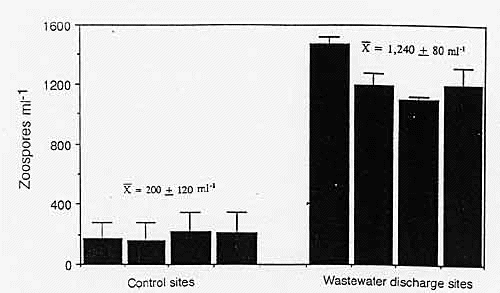VOLUME 1: Table of Contents
TEACHING ISSUES AND EXPERIMENTS IN ECOLOGY
TEACHING
ALL VOLUMES
SUBMIT WORK
SEARCH

Figure Set 4: What is the ecology and biology of Pfiesteria?
Purpose: Help students better understand the ecotoxicological effects of nitrogen loading to estuaries.
Teaching Approach: "jigsaw"
Cognitive Skills: (see
Bloom's Taxonomy) — comprehension, interpretation, application, evaluation
Student Assessment: newspaper article
FIGURE SET 4
-
Figure 4A. Response of the dinoflagellate Pfiesteria piscicada (the toxic flagellated stage) to the
fish tilapia (Oreochromis aureus) in repeat-trial experiments. The experiments were
done in aquaria and the time between death of the first fish and addition of a second
live fish was varied (cells ml-1 = cells/ml). From J. M. Burkholder, E. J. Noga, C. H.
Hobbs, and H. B. Glasgow, Jr. 1992. New 'phantom' dinoflagellate is the causative
agent of major estuarine fish kills. Nature 358: 407-410.
Figure 4B. Scanning electron micrographs of two common stages of Pfiesteria piscicada. (a) is toxic zoospore (diameter = 7-14 microns) and (b) amoeba that transformed from a toxic zoospore (cell length = 20-40 microns). Photos from NCSU Center for Applied Aquatic Ecology. From J. M. Burkholder and H. B. Glasgow, Jr. 2001. History of toxic Pfiesteria in North Carolina estuaries from 1991 to the present. BioScience 51: 827-841.
Figure 4C. Relationship between life stages of Pfiesteria piscicada and presence or absence of fish. See legend on figure for more details. From J. M. Burkholder and H. B. Glasgow, Jr. 1997. Pfiesteria piscicada and other Pfiesteria-like dinoflagellates: Behavior, impacts, and environmental controls. Limnology and Oceanography 42: 1052-1075.
Figure 4D. U.S. distribution of toxic strains of Pfiesteria (TOX-B cells are nontoxic to grown fish but sometimes have residual toxicity to sensitive larval stages of fish). From J. M. Burkholder and H. B. Glasgow, Jr. 2001. History of toxic Pfiesteria in North Carolina estuaries from 1991 to the present. BioScience 51: 827-841.
Figure 4E. Cells (NTZs - nontoxic zoospores) of Pfiesteria-like dinoflagellate (look like cells grown in the laboratory) from a depth of 0.25m at 4 control sites and 4 wastewater discharge sites (within about 100m of discharge point) in the New River estuary, North Carolina. Histograms are averages + 1 standard deviation of 3 replicate samples taken at each site. From J. M. Burkholder and H. B. Glasgow, Jr. 1997. Pfiesteria piscicada and other Pfiesteria-like dinoflagellates: Behavior, impacts, and environmental controls. Limnology and Oceanography 42: 1052-1075.
For help, see the essay "Helping Your Students to Interpret Figures and Tables."

Figure 4A. Response of the dinoflagellate Pfiesteria piscicada (the toxic flagellated stage) to the fish tilapia (Oreochromis aureus) in repeat-trial experiments. The experiments were done in aquaria and the time between death of the first fish and addition of a second live fish was varied (cells ml-1 = cells/ml). From J. M. Burkholder, E. J. Noga, C. H. Hobbs, and H. B. Glasgow, Jr. 1992. New 'phantom' dinoflagellate is the causative agent of major estuarine fish kills. Nature 358: 407-410.
<top>
______________________________________________________________

Figure 4B. Scanning electron micrographs of two common stages of Pfiesteria piscicada. (a) is toxic zoospore (diameter = 7-14 microns) and (b) amoeba that transformed from a toxic zoospore (cell length = 20-40 microns). Photos from NCSU Center for Applied Aquatic Ecology. From J. M. Burkholder and H. B. Glasgow, Jr. 2001. History of toxic Pfiesteria in North Carolina estuaries from 1991 to the present. BioScience 51: 827-841.
<top>
______________________________________________________________

Figure 4C. Relationship between life stages of Pfiesteria piscicada and presence or absence of fish. See legend on figure for more details. From J. M. Burkholder and H. B. Glasgow, Jr. 1997. Pfiesteria piscicada and other Pfiesteria-like dinoflagellates: Behavior, impacts, and environmental controls. Limnology and Oceanography 42: 1052-1075.
<top>
______________________________________________________________

Figure 4D. U.S. distribution of toxic strains of Pfiesteria (TOX-B cells are nontoxic to grown fish but sometimes have residual toxicity to sensitive larval stages of fish). From J. M. Burkholder and H. B. Glasgow, Jr. 2001. History of toxic Pfiesteria in North Carolina estuaries from 1991 to the present. BioScience 51: 827-841.
<top>
______________________________________________________________

Figure 4E. Cells (NTZs - nontoxic zoospores) of Pfiesteria-like dinoflagellate (look like cells grown in the laboratory) from a depth of 0.25m at 4 control sites and 4 wastewater discharge sites (within about 100m of discharge point) in the New River estuary, North Carolina. Histograms are averages + 1 standard deviation of 3 replicate samples taken at each site. From J. M. Burkholder and H. B. Glasgow, Jr. 1997. Pfiesteria piscicada and other Pfiesteria-like dinoflagellates: Behavior, impacts, and environmental controls. Limnology and Oceanography 42: 1052-1075.
<top>